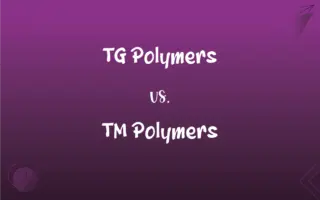Chinese Faces vs. Japanese Faces: What's the Difference?
Edited by Aimie Carlson || By Janet White || Published on February 18, 2024
Chinese faces often exhibit broader cheekbones and a rounder facial structure, while Japanese faces typically feature more elongated facial contours with higher, narrower cheekbones.

Key Differences
Chinese faces are generally characterized by broader facial structures and more pronounced cheekbones, creating a rounder appearance. In contrast, Japanese faces often have a more elongated shape with higher, narrower cheekbones, lending a more delicate appearance.
When considering the eye shapes, Chinese faces frequently have almond-shaped eyes, which may appear slightly slanted. Japanese faces, however, often showcase larger eyes with a more noticeable epicanthic fold, giving a distinct appearance.
The nose structure in Chinese faces is typically broader and flatter, which is a common trait in East Asian physiognomy. Conversely, Japanese faces often have slightly more pronounced noses with a higher nasal bridge.
In terms of skin tone, Chinese faces can vary greatly but often exhibit a yellowish or light brown tone. Japanese faces, on the other hand, usually have a relatively paler complexion, sometimes with a slight pinkish hue.
The jawline and chin shape in Chinese faces tend to be more pronounced and squarer. In contrast, Japanese faces usually feature a softer jawline with a less prominent chin, contributing to a more tapered facial silhouette.
ADVERTISEMENT
Comparison Chart
Facial Structure
Broader with pronounced cheekbones
More elongated with higher cheekbones
Eye Shape
Almond-shaped, slightly slanted
Larger eyes with noticeable epicanthic fold
Nose Structure
Broader and flatter
More pronounced with a higher bridge
Skin Tone
Yellowish or light brown
Paler with a slight pinkish hue
Jawline and Chin
Pronounced and squarer
Softer jawline, less prominent chin
ADVERTISEMENT
Chinese Faces and Japanese Faces Definitions
Chinese Faces
A typical Chinese face may feature a flatter nose.
The flat nose was a distinctive feature of his Chinese face.
Japanese Faces
Japanese faces generally have a pale complexion, sometimes with a pink hue.
The pale, slightly pink complexion was indicative of his Japanese face.
Chinese Faces
Chinese faces can exhibit a yellowish skin tone.
The yellowish tint of her skin accentuated her Chinese face.
Japanese Faces
A Japanese face usually has a higher nasal bridge.
The higher bridge of her nose was a feature of her Japanese face.
Chinese Faces
A Chinese face typically has a broad, round facial structure.
His Chinese face was characterized by its broad cheeks and round contours.
Japanese Faces
Japanese faces typically feature larger eyes with a distinctive fold.
His large eyes with a prominent fold were characteristic of a Japanese face.
Chinese Faces
Chinese faces often have almond-shaped eyes.
Her Chinese face was distinguished by her almond-shaped eyes.
Japanese Faces
Japanese faces are often characterized by a softer jawline and less prominent chin.
Her Japanese face was defined by a soft jawline and a subtle chin.
Chinese Faces
Chinese faces often have a square jawline.
His Chinese face was marked by a strong, square jawline.
Japanese Faces
Japanese faces often have an elongated facial shape.
Her Japanese face was noticeable for its elongated shape.
FAQs
What is a common characteristic of Chinese faces?
Chinese faces often have a broader facial structure and pronounced cheekbones.
What is the typical nose structure in Chinese faces?
Chinese faces usually have a broader and flatter nose.
Do Chinese faces have a specific eye shape?
Yes, Chinese faces frequently have almond-shaped, slightly slanted eyes.
Are there distinctive eye features in Japanese faces?
Yes, Japanese faces often have larger eyes with a noticeable epicanthic fold.
How are Japanese faces typically shaped?
Japanese faces usually feature an elongated shape with higher, narrower cheekbones.
What is the typical skin tone for Japanese faces?
Japanese faces usually have a paler complexion, sometimes with a pinkish hue.
Do environmental factors influence these facial features?
Yes, environmental and genetic factors both play a role in these facial characteristics.
How does the nose structure of Japanese faces differ?
Japanese faces often have a slightly more pronounced nose with a higher bridge.
Are these features static over generations?
No, facial features can evolve and change over generations.
Are these facial characteristics absolute?
No, these are general observations and there are many individual variations.
How does the jawline differ between Chinese and Japanese faces?
Chinese faces tend to have a squarer jawline, while Japanese faces have a softer jawline with a less prominent chin.
Can you find diversity in facial features within each group?
Yes, both Chinese and Japanese faces exhibit a wide range of diversity in facial features.
Is there a cultural significance to these facial differences?
While facial features are primarily genetic, they can hold cultural significance in how beauty and identity are perceived.
How does age affect these facial characteristics?
Age can change facial features, often softening or accentuating certain characteristics.
Do Chinese and Japanese faces show differences in expressions?
Facial expressions are universal, but subtle differences in facial structure can affect how expressions are perceived.
How reliable are these features for determining ethnicity?
While they can be indicative, they are not always reliable due to the diversity within each population and the influence of mixed heritage.
How do Chinese and Japanese artists depict these features in traditional and modern art?
Artists often emphasize these features in a stylized manner, reflecting cultural ideals of beauty and identity in both traditional and modern art forms.
What skin tone is common in Chinese faces?
Chinese faces can vary but often have a yellowish or light brown tone.
Do hairstyles and makeup trends influence the perception of these facial features?
Yes, hairstyles and makeup can enhance or alter the perception of facial features, sometimes accentuating ethnic characteristics.
Are these facial characteristics considered in fashion and entertainment industries?
Yes, in fashion and entertainment, these features are often highlighted or stylized to represent cultural identity or aesthetic preferences.
About Author
Written by
Janet WhiteJanet White has been an esteemed writer and blogger for Difference Wiki. Holding a Master's degree in Science and Medical Journalism from the prestigious Boston University, she has consistently demonstrated her expertise and passion for her field. When she's not immersed in her work, Janet relishes her time exercising, delving into a good book, and cherishing moments with friends and family.
Edited by
Aimie CarlsonAimie Carlson, holding a master's degree in English literature, is a fervent English language enthusiast. She lends her writing talents to Difference Wiki, a prominent website that specializes in comparisons, offering readers insightful analyses that both captivate and inform.
































































